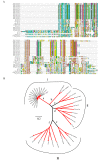An insight into the sialotranscriptome of the brown dog tick, Rhipicephalus sanguineus
- PMID: 20650005
- PMCID: PMC3091647
- DOI: 10.1186/1471-2164-11-450
An insight into the sialotranscriptome of the brown dog tick, Rhipicephalus sanguineus
Abstract
Background: Rhipicephalus sanguineus, known as the brown dog tick, is a common ectoparasite of domestic dogs and can be found worldwide. R.sanguineus is recognized as the primary vector of the etiological agent of canine monocytic ehrlichiosis and canine babesiosis. Here we present the first description of a R. sanguineus salivary gland transcriptome by the production and analysis of 2,034 expressed sequence tags (EST) from two cDNA libraries, one consctructed using mRNA from dissected salivary glands from female ticks fed for 3-5 days (early to mid library, RsSGL1) and the another from ticks fed for 5 days (mid library, RsSGL2), identifying 1,024 clusters of related sequences.
Results: Based on sequence similarities to nine different databases, we identified transcripts of genes that were further categorized according to function. The category of putative housekeeping genes contained approximately 56% of the sequences and had on average 2.49 ESTs per cluster, the secreted protein category contained 26.6% of the ESTs and had 2.47 EST's/clusters, while 15.3% of the ESTs, mostly singletons, were not classifiable, and were annotated as "unknown function". The secreted category included genes that coded for lipocalins, proteases inhibitors, disintegrins, metalloproteases, immunomodulatory and antiinflammatory proteins, as Evasins and Da-p36, as well as basic-tail and 18.3 kDa proteins, cement proteins, mucins, defensins and antimicrobial peptides. Comparison of the abundance of ESTs from similar contigs of the two salivary gland cDNA libraries allowed the identification of differentially expressed genes, such as genes coding for Evasins and a thrombin inhibitor, which were over expressed in the RsSGL1 (early to mid library) versus RsSGL2 (mid library), indicating their role in inhibition of inflammation at the tick feeding site from the very beginning of the blood meal. Conversely, sequences related to cement (64P), which function has been correlated with tick attachment, was largely expressed in the mid library.
Conclusions: Our survey provided an insight into the R. sanguineus sialotranscriptome, which can assist the discovery of new targets for anti-tick vaccines, as well as help to identify pharmacologically active proteins.
Figures







References
-
- Flechtmann CHW. Ácaros de importância médico veterinária. Vol. 104. Livraria Nobel S.A., São Paulo; 1973.
-
- Pegram RG, Clifford CM, Walker JB, Keirans JE. Classification of the Rhipicephalus sanguineus group. (Acari, Ixodoidea, Ixodidae). I. R. sulcatus Neumann, 1908 and R. turanicus Pomerantsev, 1936. Systematic Parasitology. 1987;10:3–26. doi: 10.1007/BF00009099. - DOI
-
- Walker JB, Keirans JE, Horak IG. The Genus Rhipicephalus (Acari:Ixodidae): A guide to the brown ticks of the world. Vol. 643. Cambridge University Press; 2000.
Publication types
MeSH terms
Substances
Grants and funding
LinkOut - more resources
Full Text Sources
Research Materials

